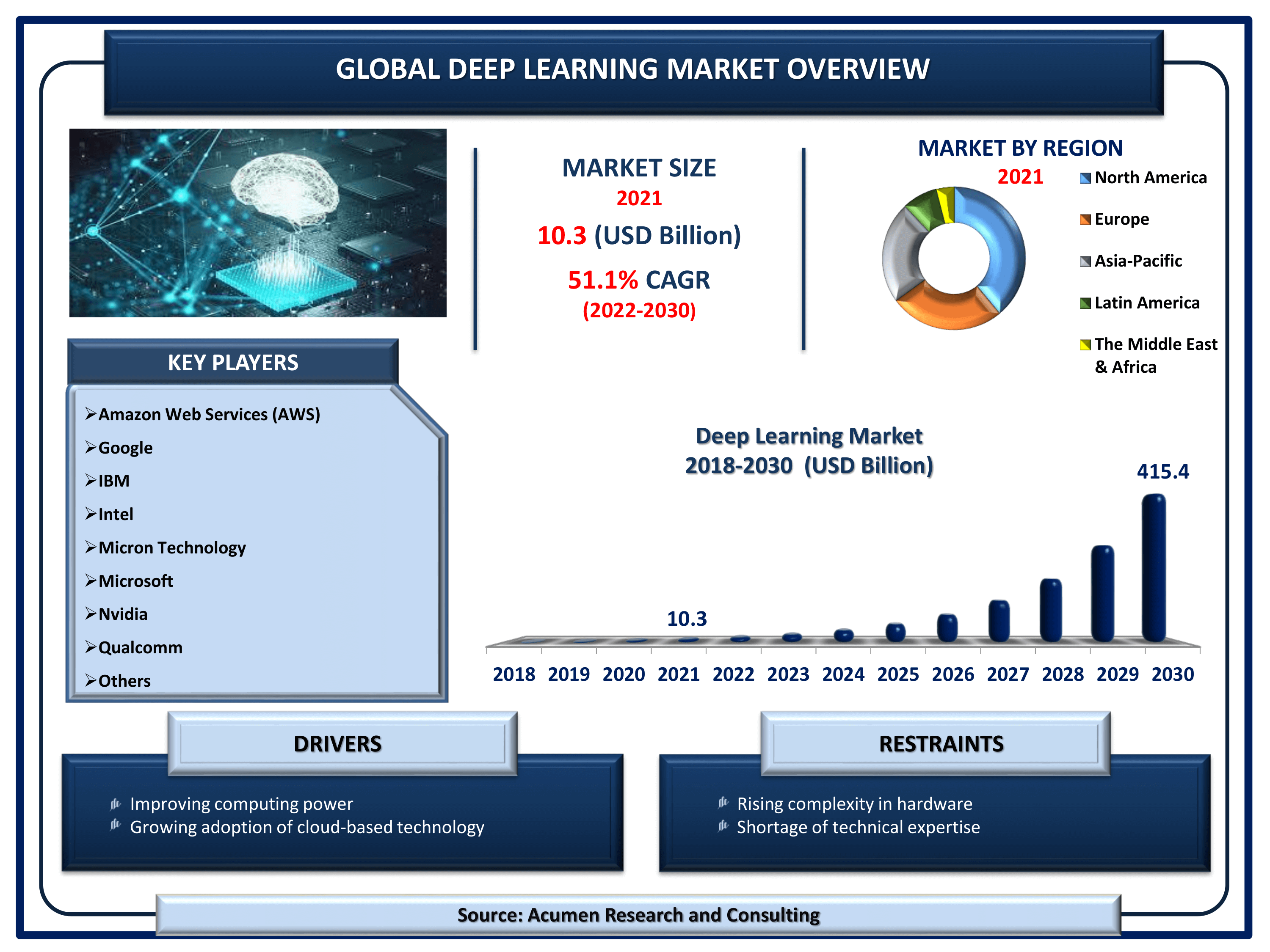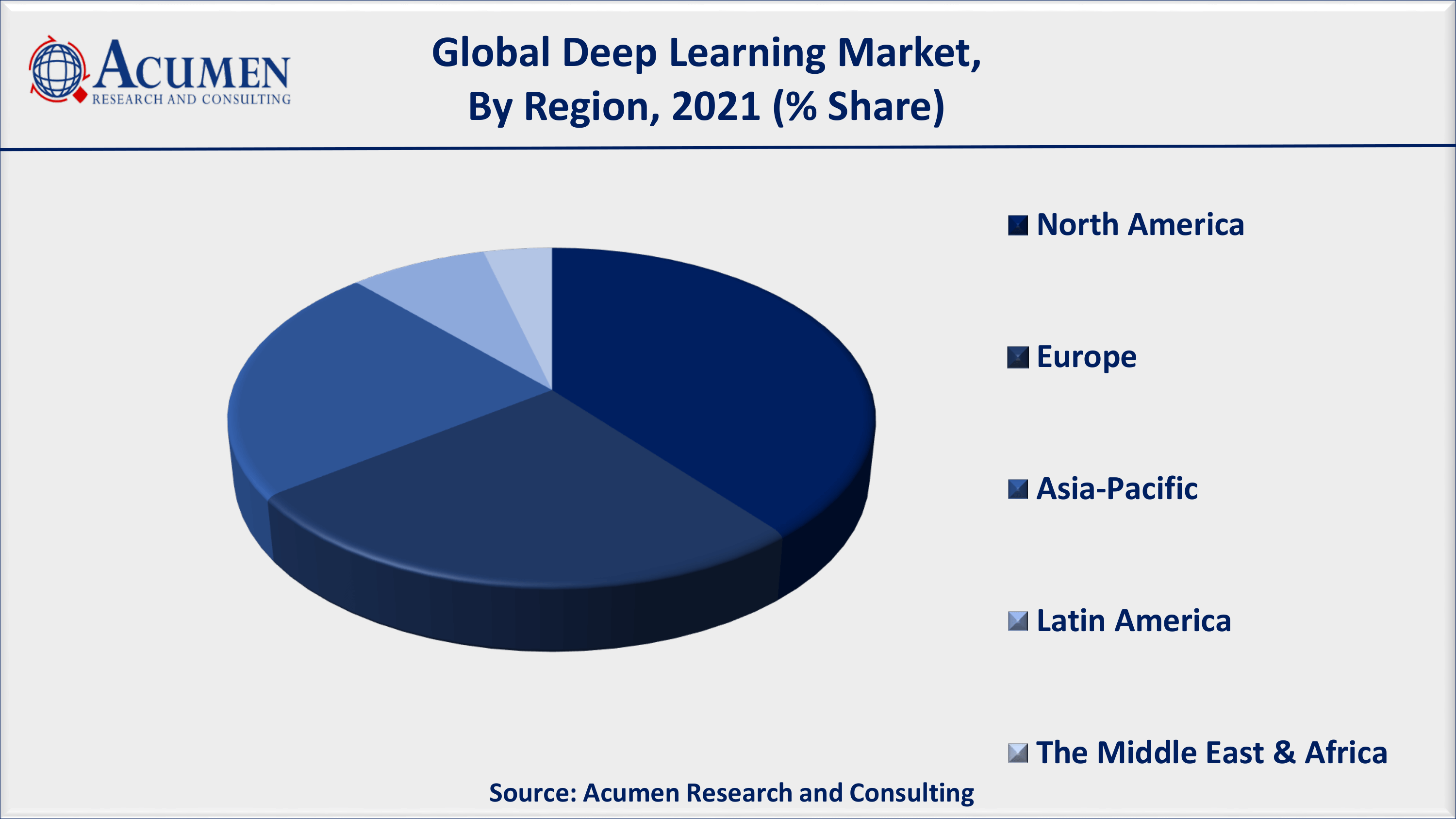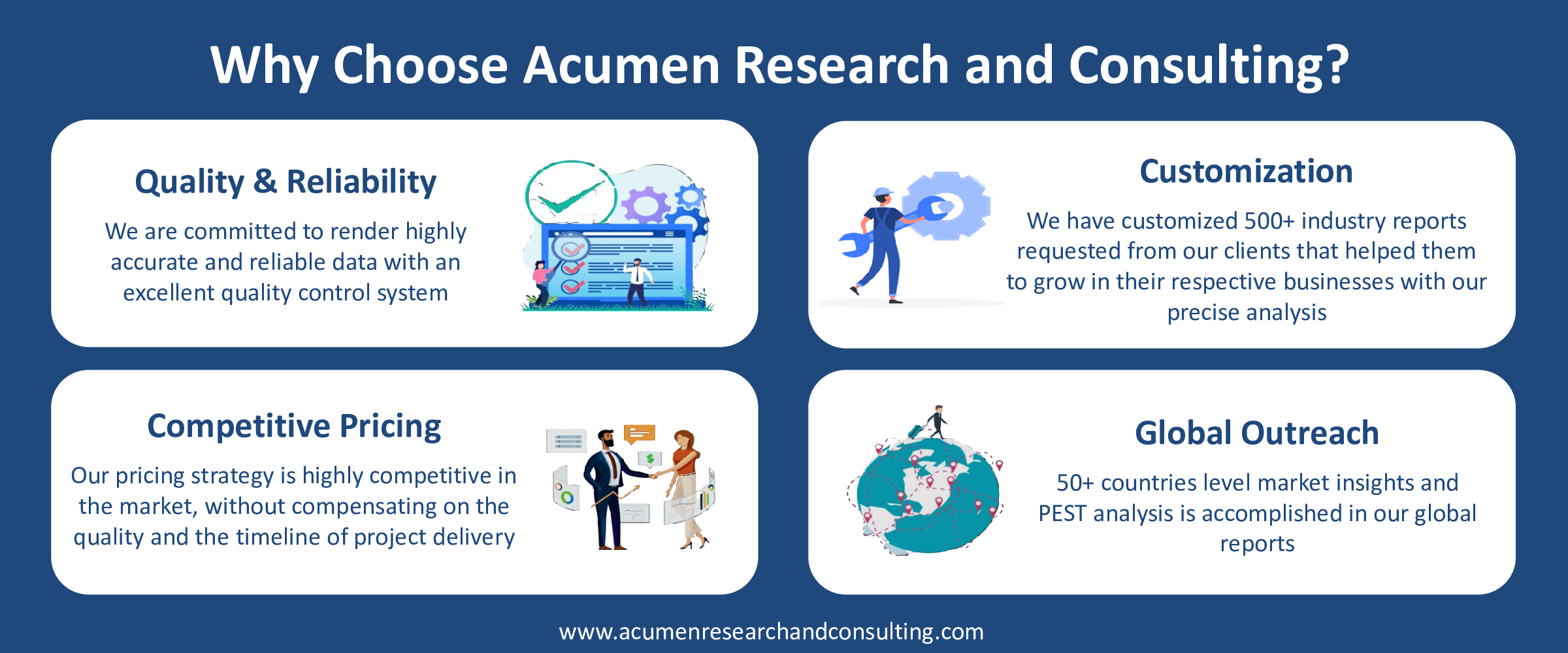Deep Learning Market Size - Global Industry, Share, Analysis, Trends and Forecast 2022 � 2030
Published :
Report ID:
Pages :
Format :
Deep Learning Market Size - Global Industry, Share, Analysis, Trends and Forecast 2022 � 2030
Report Coverage
- Industry Dynamics
- Market Size and Forecast Data
- Segment Analysis
- Competitive Landscape
- Regional Analysis with a Niche Focus on Country-Level Data
- High Level Analysis - Porter's, PESTEL, Value Chain, etc.
- Company Profiles of Key Players
- Option to Customize the Report As Per Your Specific Need
Request Sample Report
The Global Deep Learning Market Size accounted for USD 10.3 Billion in 2021 and is estimated to garner a market size of USD 415.4 Billion by 2030 rising at a CAGR of 51.1% from 2022 to 2030. Improvement in deep learning algorithm is one of the primary factors boosting the global deep learning market size. In addition, growing penetration of big data analytics is a popular deep learning market trend that is strengthening the industry growth from 2022 to 2030.

Deep Learning Market Report Key Highlights
- Global deep learning market revenue is estimated to reach USD 415.4 Billion by 2030 with a CAGR of 51.1% from 2022 to 2030
- North America deep learning market share accounted for over 39% regional shares in 2021
- According to recent findings, global data creation is projected to grow to more than 180 zettabytes by 2025
- Asia-Pacific deep learning market growth will record fastest CAGR from 2022 to 2030
- Based on component segment, software accounted for approx 50% of the overall market share in 2021
- Introduction of new hardware propels the deep learning market value in coming years
Deep learning is a subdivision of machine learning in artificial intelligence (AI) concerned with the algorithm inspired by the functioning of the human brain termed artificial neural networks. It is also termed deep neural learning or deep neural network. Deep learning is evolved with the increasing amount of unstructured data due to digitalization. The available amount of data is utilized in deep learning to process or understand that data for effective decision-making in various industry verticals including healthcare, manufacturing, automotive, agriculture, retail, security, human resources, marketing, law, and fintech.
Global Deep Learning Market Dynamics
Market Drivers
- Improving computing power
- Growing adoption of cloud-based technology
- Increasing application in big data analytics
- Rising AI adoption in customer-centric services
Market Restraints
- Rising complexity in hardware
- Shortage of technical expertise
Market Opportunities
- Growing demand for deep learning solutions in numerous industries
- Tremendous investments in deep learning technology
Deep Learning Market Report Coverage
| Market | Deep Learning Market |
| Deep Learning Market Size 2021 | USD 10.3 Billion |
| Deep Learning Market Forecast 2030 | USD 415.4 Billion |
| Deep Learning Market CAGR During 2022 - 2030 | 51.1% |
| Deep Learning Market Analysis Period | 2018 - 2030 |
| Deep Learning Market Base Year | 2021 |
| Deep Learning Market Forecast Data | 2022 - 2030 |
| Segments Covered | By Component, By Application, By End-User, And By Geography |
| Regional Scope | North America, Europe, Asia Pacific, Latin America, and Middle East & Africa |
| Key Companies Profiled | Amazon Web Services (AWS), Google, IBM, Intel, Micron Technology, Microsoft, Nvidia, Qualcomm, Samsung Electronics, Sensory Inc., Skymind, Xilinx, AMD, General Vision, Graphcore, Mellanox Technologies, Huawei Technologies, Fujitsu, Baidu, Mythic, Adapteva, Inc., and Koniku. |
| Report Coverage |
Market Trends, Drivers, Restraints, Competitive Analysis, Player Profiling, Regulation Analysis |
Deep Learning Market Dynamics
Improving computing power and declining hardware costs coupled with the rapidly growing electronics industry. The increasing adoption of cloud-based technology due to the evolution of big data is supporting the deep learning market growth. The increasing adoption of artificial intelligence (AI) based customer-centric services are further propelling the market value. The rising security issues in almost every industry vertical due to online platform usage are further accelerating market growth. In addition, the presence of fewer amounts of structured data and increasing spending in healthcare, travel, tourism, and hospitality industries is anticipated to create potential opportunities in the deep learning market.
On the flip side, increasing complexity in hardware due to the complex algorithms used in technology-based applications is projected to hamper growth over the forecast period. Additionally, the absence of standards and protocols is further expected to hinder the growth to some extent during the estimated period.
Deep Learning Market Segmentation
The worldwide deep learning market is split based on component, application, end-user, and geography.
Deep Learning Market By Component
- Hardware
- Processor
- GPU
- FPGA
- CPU
- Others
- Memory
- Network
- Processor
- Software
- Solution (Software Framework/SDK)
- Platform/API
- Services
- Installation
- Training
- Support & Maintenance
.png)
According to our deep learning industry analysis, the hardware segment is one of the important components because of the increasing need for hardware platforms with high computing power to execute deep learning algorithms. The hardware segment consists of processors such as GPU, FPGA, and CPU among others, memory, and network. The rapidly evolving R&D activities for the expansion of better processing hardware for deep learning is also accelerating the market value. Additionally, the best suitable hardware to support deep learning technology can amplify the results.
Deep Learning Market By Application
- Image Recognition
- Signal Recognition
- Data Mining
- Others
As per our deep learning market forecast, the image recognition segment dominated the global deep learning market with maximum share from 2022 to 2030. The increasing demand for optical character recognition, object recognition, pattern recognition, code recognition, facial recognition, and digital image processing is particularly propelling market growth.
Deep Learning Market By End-User
- Healthcare
- Manufacturing
- Automotive
- Agriculture Retail
- Security
- Human Resources
- Marketing
- Law
- Fintech
On the basis of end-user, the security segment held the dominating share by end-user in the deep learning market. The rising security concern due to the changing cybersecurity ecosystem is supporting the segment growth. The new types of cyberattacks are found in the organization for the concern organizations are investing in preventive measures where deep learning helps in protecting their crucial information without data loss is also positively supporting the deep learning market value.
Deep Learning Market Regional Outlook
North America
- U.S.
- Canada
Europe
- U.K.
- Germany
- France
- Spain
- Rest of Europe
Latin America
- Mexico
- Brazil
- Rest of Latin America
Asia-Pacific
- India
- Japan
- China
- Australia
- South Korea
- Rest of Asia-Pacific
The Middle East & Africa (MEA)
- Gulf Cooperation Council (GCC)
- South Africa
- Rest of the Middle East & Africa

In 2021, North America held the major share of the global deep learning market
North America dominated the global market with a major share in 2021 due to the presence of advanced technology infrastructure. The major economy of the region including the US and Canada is particularly contributing to the major share of the regional market. The high demand for deep learning applications from industry verticals including healthcare, IT, aerospace & defense, automotive, and telecommunications is additionally supporting the regional market growth.
Deep Learning Market Players
The global deep learning companies profiled in the report include Amazon Web Services (AWS), Google, IBM, Intel, Micron Technology, Microsoft, Nvidia, Qualcomm, Samsung Electronics, Sensory Inc., Skymind, Xilinx, AMD, General Vision, Graphcore, Mellanox Technologies, Huawei Technologies, Fujitsu, Baidu, Mythic, Adapteva, Inc., and Koniku. The major players involved in mergers, acquisitions and strategic partnerships for the expansion of market share.
Frequently Asked Questions
What is the size of global deep learning market in 2021?
The market size of Deep Learning market in 2021 was accounted to be USD 10.3 Billion.
What is the CAGR of global deep learning market during forecast period of 2022 to 2030?
The projected CAGR of deep learning market during the analysis period of 2022 to 2030 is 51.1%.
Which are the key players operating in the market?
The prominent players of the global deep learning market are Amazon Web Services (AWS), Google, IBM, Intel, Micron Technology, Microsoft, Nvidia, Qualcomm, Samsung Electronics, Sensory Inc., Skymind, Xilinx, AMD, General Vision, Graphcore, Mellanox Technologies, Huawei Technologies, Fujitsu, Baidu, Mythic, Adapteva, Inc., and Koniku.
Which region held the dominating position in the global deep learning market?
North America held the dominating deep learning during the analysis period of 2022 to 2030.
Which region registered the fastest growing CAGR for the forecast period of 2022 to 2030?
Asia-Pacific region exhibited fastest growing CAGR for deep learning during the analysis period of 2022 to 2030.
What are the current trends and dynamics in the global deep learning market?
Improving computing power, growing adoption of cloud-based technology, and increasing application in big data analytics drives the growth of global deep learning market.
Which component held the maximum share in 2021?
Based on component, software segment is expected to hold the maximum share deep learning market.



